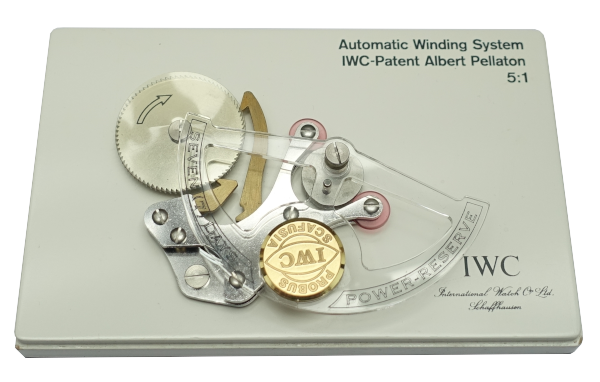In 1950, IWC launched the automatic calibers 81 (small seconds) and 85 (center second) with a new automatic winding system developed by Albert Pellaton. I was able to get hold of a 5:1 scale model of this winding system made by IWC and present it to you here, as it illustrates the functioning of the Pellaton winding system particularly clearly.

After training as a watchmaker, Albert Pellaton first worked at Vacheron Constantin, where he was already designing watch movements. In 1944, he joined IWC as technical director and held this position until his death in 1966. After starting at IWC, he focused on the development of an efficient automatic winding mechanism that would use both directions of rotation of the rotor.

In 1946, IWC patented its first automatic winding mechanism in Swiss patent CH254578. This already contained ideas in the direction of the later Pellaton winding system, but was designed as a so-called bumper automatic in which the rotor could not rotate 360 degrees. Finally, in 1950, the Swiss patent CH284841 followed, describing the Pellaton automatic.

Incidentally, the name Albert Pellaton is not mentioned in the two Swiss patents; rather, Ernest Homberger-Rauschenbach, the owner of IWC at the time, is listed as the inventor. However, his name was actually Ernst, not Ernest.
In 1951, IWC also files German patent DE882227 for the Pellaton automatic, explicitly naming Pellaton as the inventor.

So let’s take a closer look at the model!
The dimensions of the box are 13.7 x 8.6 x 4.4 cm, the lid can be removed.

Before we look at how it works, let’s first take a look at the individual parts and their names:

1 is the rotor, whose rotating motion is ultimately to be converted into tensioning of the mainspring. Here made of plastic to allow a view of the parts underneath, in the real movement of course made of metal.
2 is a cam plate that transmits the rotating movements of the rotor to the downstream pawl system. Since this is not round, it forces an up and down movement of the pawl system.
3 is the pawl carrier, the ends of which run on ruby rollers on the circumference of the cam.
4 and 5 are the crucial parts of the Pellaton automatic, the pawls.
6 is an obliquely toothed (automatic) ratchet wheel, which has a pinion on the back that transmits the energy to the winding wheels of the movement. On the caliber 85, it engages the crown wheel, which in turn winds the mainspring via the (classic) ratchet wheel. “Classic”, because it’s a different ratchet wheel than the one that belongs to the automatic winding system! In the following picture of an IWC 85, the (automatic) ratchet wheel is the gold-colored wheel.


Rather than go into a lengthy explanation of how the Pellaton winding system works, let’s take a look at it in the video:
You can see very nicely how the two pawls help to always turn the ratchet wheel in the same direction for both directions of rotation of the rotor. The mainspring can only be wound in one direction of rotation!
At first glance, it looks as if every small movement of the rotor is also transferred into a movement of the ratchet wheel. In the next video, however, you can see that there are also short moments in between when the pawls move but not the ratchet wheel.
The Pellaton automatic experienced a rebirth at IWC in 2000 with the caliber 5000 in the Portugieser Automatic. In the meantime, the Pellaton winding mechanism has become the signature of IWC’s own calibers.
Seiko developed a similar winding concept in 1959 with the Magic Lever. This also uses two pawls, but the construction is much less complex than that of the Pellaton winding system.

There is also a significant difference between the two systems: in the Pellaton winding system, both pawls pull on the ratchet wheel; in the Magic Lever, one pawl pulls and the other pushes the ratchet wheel. What both have in common is that one of the pawls in each case serves as a backstop to prevent the ratchet wheel from turning in the wrong direction.

Source: [https://museum.seiko.co.jp]

Très belle analyse technique vidéo à l’appui, calibre très précis réel chronomètre, heureux possesseur d’une IWC CALATRAVA Platine 1962 calibre 8531
J. D